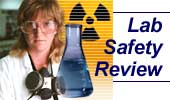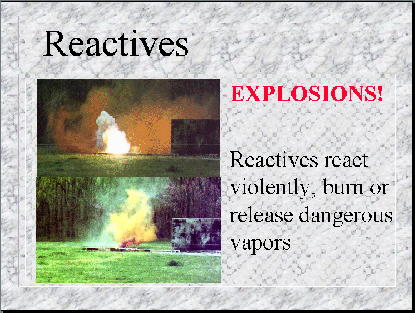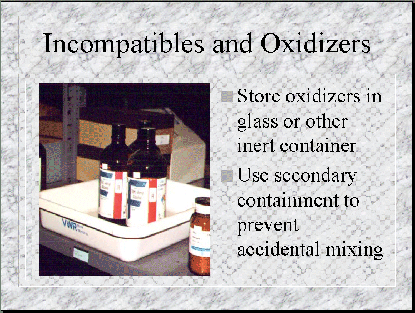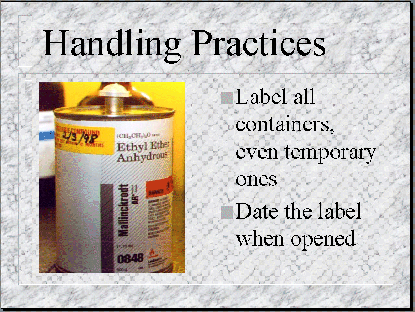LAB SAFETY REVIEW: Reactives

By Michael Balanoff

Lab Safety Review is a new monthly column on Safety Online and Laboratory Network.com. Each edition is written by a specialist in this important field.
To protect employees from "reactives" used in laboratory settings, a basic understanding of the chemicals and their behaviors is helpful.
Many people think of explosions when they hear the term "reactives."
Indeed, reactives are known to react violently on occasion, causing mass destruction. The class of chemicals, however, includes many other nasty traits, including burning extremely rapidly under ambient conditions.
Reactives are also known to release highly toxic or corrosive vapors. Conditions that could cause these dangerous reactions include such common conditions as moisture, shock, light, movement, age, air, or friction.

There are a number of categories for dangerous reactions. Each of these categories has special handling and storage considerations. The categories include: self-polymerization, water-reactives, pyrophorics, peroxide formation, incompatibles and oxidizers, shock sensitive, and high explosives.
Categories
Self-polymerization refers to a group of chemicals that create their own reaction when two or more small molecules (monomers) combine to form chains of repeating structures (polymers). When this reaction starts within the container of monomer, it can result in extremely high temperatures or pressures.
Water reactives are chemicals that react violently with water. One or more of a number of things can happen. They may release heat; release flammable, toxic, or oxidizing vapors; release metal oxide fumes; or form corrosive acids.
Pyrophorics are those chemicals that react with air to ignite into fire. The reaction is so vigorous and instantaneous that it appears to be spontaneous. A small leak or spill may involve the entire container in a very hot fire faster than a response can be made.
Peroxide formation occurs in many common laboratory chemicals when the chemical naturally decomposes to peroxides, which are unstable and capable of detonation in even low concentrations. Oxygen taken from air, water, or impurities is incorporated into the chemical structure, forming peroxides. This is an insidious reaction since it happens in ambient conditions and without a visible by-product. It makes peroxide-forming chemicals some of the most hazardous materials found in the laboratory
Incompatibles or oxidizers may be stable on their own, but when mixed with the wrong chemical, may react vigorously. Oxidizers are also known to spontaneously ignite a combustible chemical; undergo an explosive reaction when exposed to heat, shock, or friction; and contribute oxygen to a fire.

Shock sensitive chemicals may explode with slight movement or heat. Some chemicals are by nature shock sensitive. Others become shock sensitive through drying, aging, decomposition, or reaction.
High explosives detonate with a shock wave that travels faster than the speed of sound. The shock wave carries enough energy that it can knock over walls, break windows and compress the lungs and heart to stop function. These cause extreme damage and even death.
General Storage and Handling Precautions
There are a number of general storage and handling precautions that will reduce risk and protect employees who must use reactives. Here are a few basic tips you can share with management, employees, or coworkers:
- Know what makes the chemical reactive.
- Store reactives in cool, dry locations.
- Ventilate the work area.
- Label all containers.
- Protect from shock, friction, or grinding.
- Strictly limit quantities stored.
- Keep a barrier between the reactive and you.
- Wear appropriate personal protective equipment (PPE).

Summary
Reactives hazards from chemicals encompass a wide range of safety concerns. Most chemicals in the lab include reactive hazards that have not been acknowledged in the past. Yet these hazards can cause great harm.
Knowledge of the hazards associated with reactives, and application of proper handling and storage practices, can prevent a tragedy.
Excerpted from the Lab Safety Training Module: Reactives, by Michael Balanoff for publisher ChemSW Inc. (www.chemsw.com). Lab Safety Training offers 13 software training modules in Microsoft PowerPoint, including: Flammables, Corrosives, Fume Hoods, Reactives, Spill Control, Toxics, Lab Ergonomics, PPE in the Lab, Physical Hazards, Introduction To Pollution Prevention in the Lab, Template for Lab Pollution Prevention, Pressure Hazards, and Safety Equipment in the Lab.
